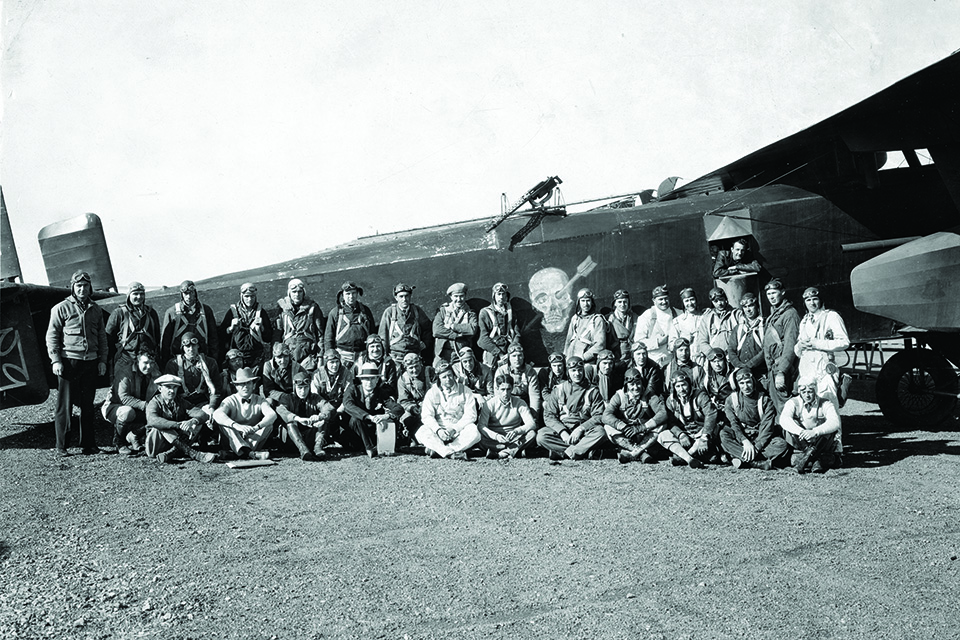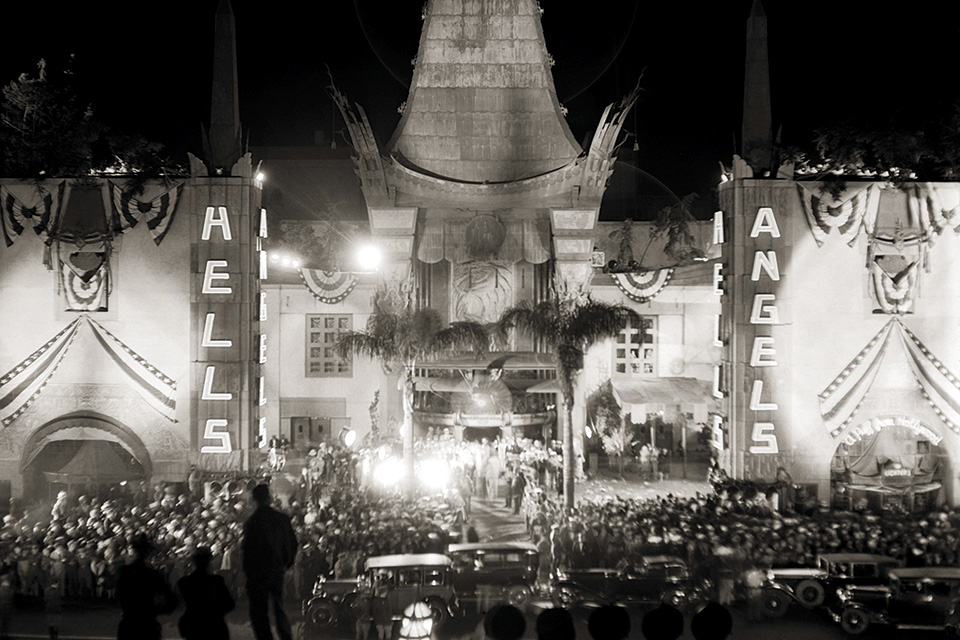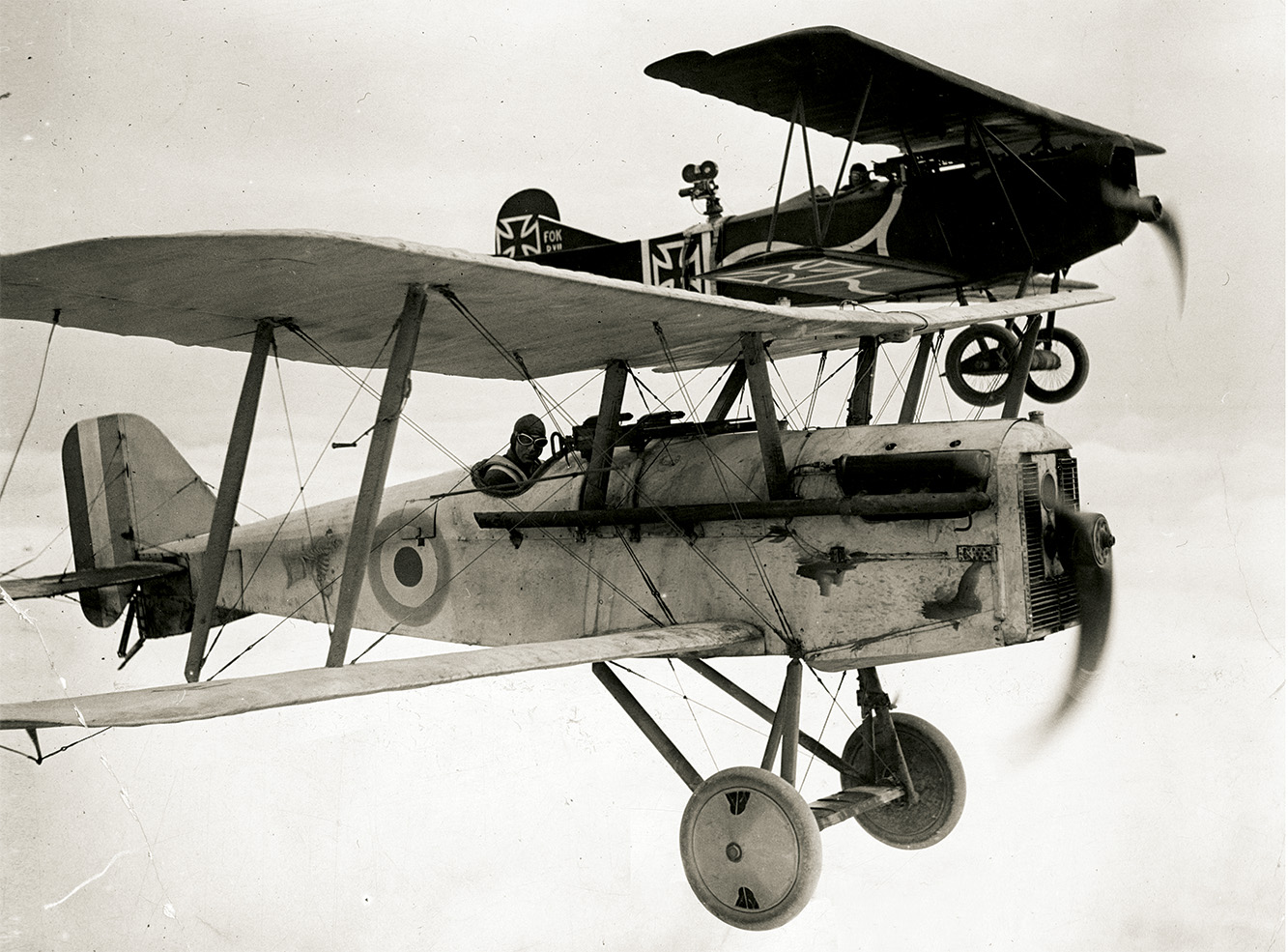The menacing squadron of Fokker D.VIIs, led by legendary ace Manfred von Richthofen, prowled in tight formation against a tranquil backdrop of thick, billowy clouds. The wide-open canvas, however, soon became cluttered with the arrival of scores of British aircraft.
What followed was the most dizzying, fierce dogfight ever witnessed, featuring a steady exchange of blistering gunfire and acrobatic maneuvering—until the action was suddenly halted with a single command: “Cut!”
The hair-raising scene took place over the skies of northern California, not battle-torn Europe. And the order wasn’t given by a high-ranking officer, but by 23-year-old novice director and aviation enthusiast Howard Hughes Jr., shooting his epic World War I movie, Hell’s Angels. Ultimately, most of the film’s drama would play out off-screen, including transitioning from silent film to sound, recasting lead actors, the death of four airmen and a scandalous performance by an unknown teenage actress, Jean Harlow. But then and now, the movie is best remembered for the stunning aerial sequences that signaled the arrival of Hughes on the world stage.
Hughes’ interest in flight developed at an early age. His father, a Houston businessman who made a fortune developing oil-drilling equipment, treated his son to a short ride aboard a Curtiss flying boat. Senior got sick, but junior was thrilled, sparking a lifelong love of flying—especially seaplanes. His dream of becoming an aviator was soon realized when his father died in 1924, making Howard a millionaire at the tender age of 19.
After taking the helm of the Hughes Tool Company and an arranged marriage to Ella Rice, a wealthy socialite and grand-niece of the founder of Rice University (where Hughes dropped out after his freshman year), the ambitious young man headed west to make a name for himself in the burgeoning movie industry—the first of many obsessions that defined his remarkable and often turbulent life. Hughes wasted little time, producing some low-budget films and getting a taste of the decadent Roaring Twenties lifestyle. He bought a 30-room hacienda-style mansion in the tony Hancock Park neighborhood situated next to L.A.’s Wilshire Country Club. The location allowed him to hobnob with the Hollywood elite while indulging in another passion: golf. Additionally, Hughes began learning to fly at Clover Field in Santa Monica and purchased a Waco 10 with a 220-hp Wright J-5 engine, a plane he had completely rebuilt and customized with leather and rubber padding in the cockpit.
The success of Paramount’s 1927 war drama Wings, which would win the first Academy Award for Best Picture, motivated Hughes to make his own flying film—only bigger and better. Moreover, he was determined to make the movie on his own terms without any meddling from the all-powerful studio system. It also required the shy, lanky Texan to put up his own money for a budget that would continue to escalate throughout the production.
Hughes purchased a short story from his friend Marshall Neilan, and hired him to direct. Neilan would be the first of three directors to run afoul of the temperamental Hughes, who at times took the reins himself. The film’s simple plot revolved around two disparate brothers, Monte and Roy (played by Ben Lyon and James Hall), schoolboys at Oxford until WWI breaks out. Succumbing to a lukewarm call of duty, they join the Royal Flying Corps while getting tangled up in a love triangle with Helen, a less-than-virtuous local gal (Greta Nissen), who along with Monte’s yellow streak jeopardizes a daring bombing mission against the Germans. Got it? Doesn’t matter. The star of the show would be the death-defying action when filming began in the fall of 1927.
Eager to prove himself to the stable of ace pilots he would soon employ, Hughes accumulated the requisite number of flying hours and received his pilot’s license. He then hired top stunt pilot Frank Tomick, who later recalled his first meeting with the future mogul: “He told me he needed a bunch of planes. Camels, S.E.5s, D.VII Fokkers. ‘Get all you can.’ So we went out all over the country, wired and found out where they kept some planes.”

Hughes spared no expense rounding up as many vintage WWI aircraft as possible, determined to make Hell’s Angels look genuine and realistic. He acquired five D.VIIs, two Royal Aircraft Factory S.E.5as and two Sopwith Snipes, but eventually disguised several American-made biplanes to resemble actual warbirds. Thomas-Morse S-4C Scouts doubled as Sopwith Camels; Curtiss JN-4 “Jennys” became Avro 504Ks; Travel Air 2000s (“Wichita Fokkers”) helped complete an enemy squadron; and a massive, twin-engine Sikorsky S-29A received a heavy makeover for its transformation into a German Gotha bomber. In all, Hughes bought or leased more than 40 planes (although he often exaggerated the number to nearly 100), and now shifted his focus to find the very best pilots to fly them.
Tomick helped recruit an elite corps of leading stunt pilots, barnstormers and WWI aces. The impressive lineup included Roscoe Turner, Frank Clarke, Al Wilson, Roy Wilson, Leo Nomis, Ira Reed, Ross Cooke and Maurice “Loop Loop” Murphy (world-record holder for 120 consecutive loops). Several airfields were used throughout the area, but to ensure secrecy, the notoriously paranoid Hughes converted a cow pasture in Van Nuys into a private airstrip and named it Caddo Field. Something he couldn’t buy were clouds, a necessary point of reference to contrast the speed, depth and direction of the planes. The unfavorable conditions led to long, costly delays and snarky production signs declaring “War Postponed—No Clouds Today!”
While sequestered for lengthy periods in the hot sun, the restless daredevils enjoyed playing practical jokes on their eccentric, hotheaded boss. One such prank involved waiting for Hughes to enter the sole outhouse located on the rural grounds. Tomick then jumped into a nearby parked Airco DH-4 camera plane with its tail pointing directly at the primitive comfort station. A few other airmen helped crank the propeller as Tomick throttled the engine, causing the outhouse to topple over in a cloud of dust. Hughes was furious, and after crawling out of the makeshift men’s room, fired the entire crew. But replacing hotshot pilots—a rare commodity—was difficult, and the merry pranksters were all rehired within an hour.
In addition to lighthearted hijinks, the tight-knit group of aviators would experience several tragedies on set. Al Johnson ran into tension wires while delivering parts from Glendale and suffered horrific burns. He died the next day. Later, C.K. Phillips was killed after crashing an S.E.5a, and Rupert Syme Macalister, an Australian pilot, died in an accident that was never fully explained. Hughes nearly added to the list of fatalities when he attempted a risky stunt in one of the Thomas Morse Scouts. The “Tommy Scout” featured a rotary engine and could be tricky to handle. In his book Howard Hughes: Aviator, ex-fighter and -test pilot George J. Marrett described it this way: “On takeoff the plane developed a strong gyroscopic effect when the tail was lifted because of the rotation of the huge mass of the engine metal. This reaction caused the aircraft to veer off course, so its pilot would need to apply a large amount of rudder.”
Hughes, not accustomed to being told “no” and determined to show the flying experts he wasn’t a greenhorn, climbed into the Tommy Scout’s cockpit at Mines Field (now LAX airport). Shortly after takeoff, he lost control and crashed hard, breaking bones in his face that required surgery and caused further delays. Production eventually resumed, but the skies above L.A. remained cloudless. Hughes then turned his attention to an elaborate setup, featuring miniature Zeppelins and life-size stuntmen. Shot inside a government dirigible hangar in Arcadia, the scene called for a bombing raid over London’s Trafalgar Square followed by a ridiculous subplot involving a German-born Oxford classmate of Roy and Monte’s, and several Kaiser-loving soldiers dutifully jumping to their deaths. Despite the corny melodrama, the appearance of the ghost-like airship would leave a haunting impression on audiences, and later prominently featured in Martin Scorsese’s biopic The Aviator.
In late October 1928, Hughes finally got his white, fluffy clouds to begin shooting the climactic dogfight scene. There was just one problem: The clouds were in Oakland. All cast, crew and equipment were hurriedly relocated to northern California, where Hughes meticulously staged his masterpiece. He worked closely with his chief aerial cinematographer, Harry Perry, to pioneer innovative techniques and intricate choreography. They placed multiple cameras inside several aircraft as well as remote-controlled outside mounts to capture the emotions of the pilots’ faces while simultaneously recording the whirling intensity of an air battle. Hughes conducted most of the action aboard one of the camera ships, relentlessly demanding perfection and earning the nickname “Hundred Takes Hughes.” His insistence on realism and not trick photography resulted in breathtaking sequences, and the only models used in the final dogfight were two 12-foot D.VIIs that were shown colliding in midair and bursting into flames.
On March 22, 1929, tragedy struck once again when mechanic Phil Jones died in a designed crash of the Sikorsky. Al Wilson piloted the behemoth aircraft portraying the German bomber to an altitude of 7,500 feet before launching into an uncontrollable tailspin. Wilson managed to bail out, but Jones, who had been operating a smoke generator filled with lamp black, failed to get out in time and was killed on impact.
The advent of “talkies” created another unexpected setback that threatened to derail the production. Al Jolson’s The Jazz Singer had recently ignited the box office, and the public demanded more. Facing ruin and having already spent $2 million, Hughes decided to go all in and make Hell’s Angels be heard—loudly. Fortunately, his coveted aerial footage could be salvaged by simply adding sound effects, but nearly all of the dialogue scenes required reshoots. Hughes would also need to quickly replace his Norwegian-accented leading lady. He then brought in director number four, James Whale, who later went on to direct Boris Karloff in Frankenstein, but now turned his attention to a “monster” of a different stripe.

Jean Harlow had only appeared in a handful of bit parts (including a few Laurel and Hardy comedies), but the 18-year-old platinum blonde knockout from Kansas City was about to become a household name and international sex symbol. The slight hiccup that she couldn’t act didn’t stop Hughes from casting her in the role of fun-loving Helen. After all, the camera loved her—and the combo of Harlow’s risqué wardrobe and bawdy talk easily compensated for any lack of dramatic talent. Furthermore, the film set the tone for most of Hughes’ future films, offering thin plots buoyed by plenty of action and sexual innuendo.
Hughes’ relationship with his wife became yet another casualty of the picture. Workaholic hours and a steady stream of dalliances doomed the marriage and sent Ella back to Houston for an uncontested divorce. The infamous “Black Friday” stock market crash in October 1929 didn’t help matters either. But Hughes plowed forward nonetheless with dogged determination, sifting through more than 500 hours (2.5 million feet) of footage (he sold many of the unused scenes and outtakes to other studios for years afterward). The final cut featured a mashup of scenes with dialogue, silent sequences with titles, dubbed sound and even an eight-minute color scene—the only one in Harlow’s career.
By the time of its release on May 27, 1930, Hell’s Angels had cost $2.8 million, becoming one of the most expensive movies made to date. Hughes inflated the production cost (and subsequent profits) for publicity purposes, but his splashy Hollywood premiere at Grauman’s Chinese Theatre remains unsurpassed. Thousands of spectators lined Hollywood Boulevard as speeding aircraft flew overhead, producing red, white and blue trails; stuntmen parachuted into the crowd; massive floodlights lit up the night sky; and 600 policemen along with National Guard troops were called in to control the frenzied crowd, clamoring to glimpse the small army of movie stars on hand for the spectacular gala event.
In the end, however, Hughes’ star shined brightest. The brash, tall playboy triumphantly used the platform for his movie to build a vast empire and emerge as a record-setting aviator. And nearly 90 years later, the air battles featured in Hell’s Angels are widely regarded as some of the most memorable ever shot and a landmark achievement in cinematic history.
Christopher Warner is an actor and freelance writer who has written extensively about military history. Further reading: The Motion Picture Stunt Pilots and Hollywood’s Classic Aviation Movies, by H. Hugh Wynne; and Seduction: Sex, Lies and Stardom in Howard Hughes’s Hollywood, by Karina Longworth.
This feature appeared in the September 2019 issue of Aviation History.






